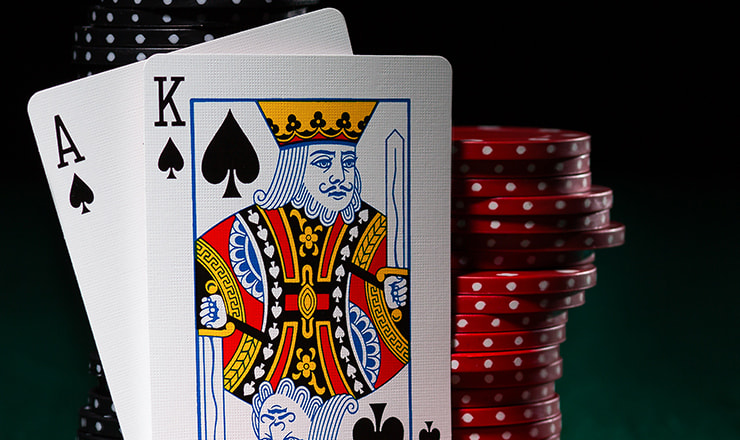Mastering Blackjack: Strategies for Hitting, Standing, and Splitting
Unlock the secrets to blackjack success in this concise guide. We cover critical moves like hitting, standing, and splitting, plus we offer betting insights. It’s all about sharpening your skills and gaining an edge at the table with simple blackjack strategies Ready to play with confidence?
Blackjack Basics: Winning by the Numbers
At its core, blackjack aims for players to beat the dealer’s hand without exceeding a total of 21. Each card contributes its face value towards this goal, with face cards valued at 10 and aces flexible at 1 or 11, depending on the hand’s needs.
A typical hand unfolds with players receiving two cards, deciding to hit (take another card), stand (keep the current hand), double down, or split pairs. The dealer follows set rules for hitting or standing, aiming to outscore players without busting over 21.
Hit or Stand: Making the Right Move
Deciding whether to hit or stand in blackjack hinges on assessing your hand against the dealer’s visible card. Generally, players should consider hitting when their hand totals 11 or less, ensuring no risk of busting and maximising chances of improving the hand.
Conversely, standing is advisable when holding a hand value of 17 or higher, as the risk of busting outweighs the potential benefits. For hand values between 12 and 16, players should weigh the dealer’s card, standing if the dealer shows a low card (2-6) and hitting if higher.
Splitting Pairs: Doubling Down on Strategy
Splitting pairs when playing at blackjack sites allows players to divide a pair of matching cards into two hands, doubling the bet but offering a chance to maximise wins. It’s a strategic move, especially advantageous with pairs of Aces and 8s, as splitting these can drastically improve potential outcomes.
However, not all pairs should be split. For instance, splitting 10s is often discouraged because a hand total of 20 is already strong against most dealer cards. Knowing when to split requires understanding the game’s dynamics and the dealer’s upcard to enhance winning chances without unnecessarily increasing risk.
Blackjack Basics: Winning by the Numbers
Doubling down in blackjack allows players to double their bet in exchange for committing to stand after receiving just one more card. This move can significantly amplify your winnings, making it a potent tool in the right circumstances.
Ideally, you’ll want to double down when your hand totals 11, giving you a strong chance of hitting a 21 with a 10-value card. Considering this option with a hand of 10 is also strategic, especially if the dealer’s upcard is weak (ranging from 2 to 9).
Understanding when and how to leverage the double down option can turn a good hand into a great one, boosting your odds of coming out ahead.
Strategic Insights: Beyond the Basics
Aiming to beat the dealer rather than hitting 21 is a fundamental blackjack strategy. It shifts focus to a more achievable goal, enhancing decision-making during play.
Standing on a hand value of 17 or higher is wise, reducing the risk of busting and relying on the dealer to potentially overdraw.
- Stand with a 12-16 hand if the dealer shows a 2-6.
- Hit if you have 12-16 and the dealer’s card is 7-Ace.
- Always opt to split when you have Aces or 8s.
- Double down when holding an 11 against a dealer’s 2-10.
- Consider hitting or doubling down with an Ace-6 hand.
Splitting 10s is generally discouraged; holding onto a strong hand of 20 is often more advantageous than risking it for a potentially lower value, considering the dealer’s upcard in your strategy can significantly influence your moves.
- Never take insurance; it’s generally a losing bet.
- Avoid the temptation to stand on a soft 17 (Ace-6); hit to increase your chances of improving your hand.
- Double down on a 10 when the dealer’s upcard is 9 or lower to maximise your profit potential.
- Stand on a hard 17 or higher; the risk of busting outweighs the potential benefits of hitting.
- Consider surrendering a 16 against a dealer’s 9, 10, or Ace to save half your bet when defeat seems likely.
Blackjack Betting Systems: Play Smart, Bet Smarter
Betting systems in blackjack, such as the Martingale, Fibonacci, and Flat betting, offer structured approaches to wagering. The Martingale system involves doubling your bet after each loss, aiming for a single win to recover all losses plus a profit.
The Fibonacci system uses a sequence where each bet is the sum of the two preceding ones, offering a less aggressive strategy than the Martingale. It’s designed to mitigate losses over a more extended play period but requires attention to sequence.
Flat betting stands out for its simplicity: betting the same amount regardless of wins or losses. This method is favoured for its low risk, making it suitable for beginners or those with a smaller bankroll.
While betting systems can add structure to your blackjack strategy, they don’t reduce the house edge. The key drawback is the potential for rapid bankroll depletion, especially with systems that require increasing bets on losses. Thus, understanding each system’s mechanics and risks is crucial before implementation.
Conclusion – Get Ready to Play
We’ve navigated through essential blackjack strategies, from when to hit, stand, or split, to leveraging betting systems like Martingale and Fibonacci. Understanding these tactics is crucial for making informed decisions and enhancing your gameplay.
Employing a solid strategy in blackjack can significantly impact your success rate. It’s not just about the cards you’re dealt but how you play them. Intelligent betting, knowing when to split or double down, and managing your bankroll contribute to a more rewarding experience.
Ultimately, mastering blackjack strategy requires practice and patience. Remember, the goal is to outsmart the dealer and maximise your winning potential while minimising losses. Stay disciplined, keep learning, and enjoy the journey to becoming a more skilled Blackjack player.
Frequently Asked Questions
While playing blackjack is relatively easy, there are certain plays to be aware of. Below, we’ve added some answers to frequently asked questions. Understanding these concepts is vital to enjoyment and success in this fascinating game.
 Written by:
Written by:
